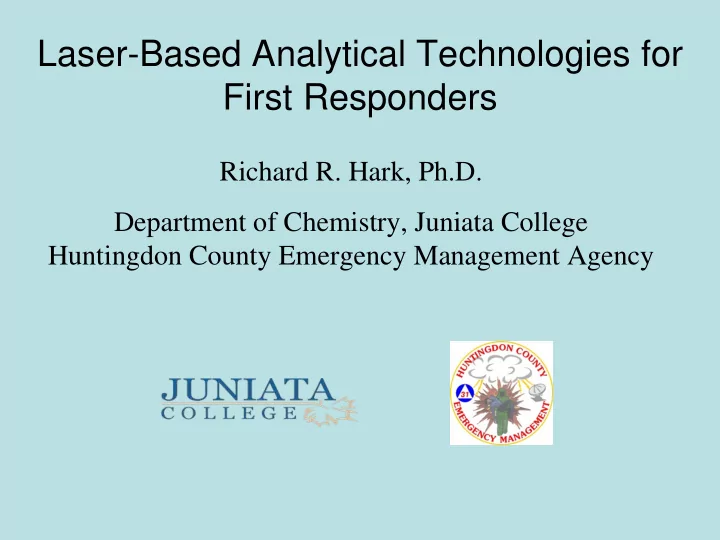

Laser-Based Analytical Technologies for First Responders Richard R. Hark, Ph.D. Department of Chemistry, Juniata College Huntingdon County Emergency Management Agency
First Responder Scenarios Train derailment Hart Office Building (Graniteville, SC) (Washington, DC) Willis “Sears” Tower (Chicago, IL) Beaver Stadium Hazmat spill (State College, PA) (Bloomington, IN)
What’s Important to a First Responder? First Responders are routinely faced with the challenge of rapidly and reliably identifying unknown substances encountered in a wide range of field conditions. An extensive array of field tests and portable instrumentation have been developed and/or adapted for the purpose of detecting the presence of CBNRE threats, TIC’s/TIM’s, and illegal drugs, along with the benign substances (e.g., harmless white powders) commonly encountered during First Responder operations. Laser-based analytical instruments are routinely used by First Responders and new systems are currently being developed for potential use by the thousands of FR organizations. Important questions include: • “Will it give me a reliable, unambiguous answer that allows me to make situation-dependent critical decisions in a timely fashion? What is the Situational Utility Value (SUV) of the instrument?” • “What is the false positive and false negative identification rate?” • “Can I use it in the Hot Zone in a Level A Chemical Protective Suit and, if so, can the unit be decontaminated?” • “How close do I have to get?” [ time + distance + shielding = safety ] • “Can a non-expert First Responder use the instrument?” “Is there technical support?” • “What is the trade-off between size/weight and performance (dynamic range, sensitivity, specificity, resolution)?” • “How much does it cost to buy and operate?” “How long will it last?”
FTIR Spectroscopy Application • TIC’s/TIM’s • chemical and explosive threats Mobile-IR TruDefender FT • drugs (Bruker) (T hermo Scientific) • white powders Advantages • mature technology in the laboratory • good specificity • no fluorescent interference • non-destructive HazMatID Ranger • some units suitable for Hot Zone operations (Smiths Detection) HazMatID 360 • open path systems monitor for pollutants or (Smiths Detection) CWA’s Disadvantages • cannot be used with aqueous samples • qualitative but not typically quantitative applications Cost • $25,000 – 100,000+ ID100 RAPID (Environics) (Bruker)
Raman Spectroscopy Applications • TICs/TIMs FirstDefender RMX • chemical, biological and explosive threats (Thermo Scientific) • drugs • “white powders” RespondeR RCI Advantages (Smiths Detection) • good specificity • can be used with aqueous samples ReporteR • “sees through” glass or plastic bottles (DeltaNu) • non-destructive • can be used in stand-off configuration • some mixtures can be successfully analyzed using InPhotote chemometric software (InPhotonics) • some units suitable for Hot Zone operations • increased sensitivity using SERS (ppm/ppb levels) StreetLab Mobile Disadvantages (Morpho Detection) • autofluorescent compounds give poor spectra • not suitable for some explosives or dark materials • inherent low sensitivity of technique Cost 1stGuard RamanID • $25,000 – 75,000 (BaySpec) (RTA)
Laser-induced Breakdown Spectroscopy (LIBS) Applications Insight • TICs/TIMs (Photon Machines) • full spectrum of CBRNE threats • “white powders” “backpack unit” (2003) Advantages (Ocean Optics) • real time elemental analysis of small quantities of solids, liquids, gases and aerosols • no sample preparation, only micro-destructive RT100-HP • multiple configurations- laboratory, field portable, (Applied Spectra) stand-off, vehicle or robot mounted Porta-LIBS 2000 Disadvantages (StellarNet) • not suitable for shock sensitive explosives • environmental background can hamper identification • concern about eye safety for stand-off systems • non-interoperability of libraries Stage of Development Mini-ST LIBScan • several small companies producing units suitable for (Applied Spectra) (Applied Photonics) FR use but no turnkey systems yet available • some Federal funding for FR applications through DoD • library development lagging • chemometric software/user interface maturing Cost • ~$50,000 – 150,000+ Short standoff LIBS PL100-GEO (Applied Photonics) (Applied Spectra)
What’s on the Horizon for First Responders? Laser Photothermal Imaging Utilizes an eye-safe Quantum Cascade Laser (QCL) which is tuned to absorption bands of the materials of interest. When they absorb the laser radiation, the material heats up and gives off a thermal signature that is picked up by IR cameras. Photodissociation/Laser Induced Fluorescence (LIF) One laser causes the nitro groups in explosive molecules to fall apart while a second laser identifies the characteristic fragment formed. “Smart(er)” Chemometric Software with Better Algorithms Smaller Components, Economy of Scale/Reduced Cost Sensor Fusion of Orthogonal Techniques • FTIR and Raman (nearly fully integrated) HazMatID 360 and • LIBS and Raman (demonstrated utility) RespondeR • LIBS and LIF (needs to be explored further) (Smiths Detection)
Applications of Laser-based Analytical Technology Environmental Applications • rapid survey of contaminated sites • assessment of industrial or mining operations on the environment • in situ analysis of lead in paint Analysis and Preservation of Cultural Heritage Objects • identification of pigments and other components of artworks Raman microscopy for and archeological artifacts analysis of pigments Analysis of Geomaterials • real-time analysis of coal for more efficient energy production • analysis of ‘conflict minerals’ (e.g. coltan) Columbite-tantalite ore Space Exploration • a LIBS unit will be part of NASA's Mars Science Laboratory (MSL) rover scheduled for a 2011 launch • the European Space Agency has also planned a combined Raman-LIBS for the Pasteur instrument payload on the ExoMars rover mission with an anticipated launch in 2016 ESA LIBS/Raman unit For ExoMars mission
Acknowledgements � LIBS Research Group • Samantha Bristol • Keith Hilferding • Alyssa Kress • Katrina Shughrue • Benjamin Tansi • Rebecca Weih � Adam Miller, Huntingdon County Emergency Management Agency � Dr. Andrzej Miziolek, Army Research Laboratory � Dr. Russell Harmon, Army Research Office � Dr. Michael Wise, Smithsonian Institution � Dr. Lucia Burgio, Victoria and Albert Museum (London, UK) � Professor Robin J.H. Clark, University College London � Lucille East, Dr. Jhanis Gonzalez; Applied Spectra, Inc. (Fremont, CA) � DoD/Army Research Office for funding � American Chemical Society � Optical Society of America
Recommend
More recommend